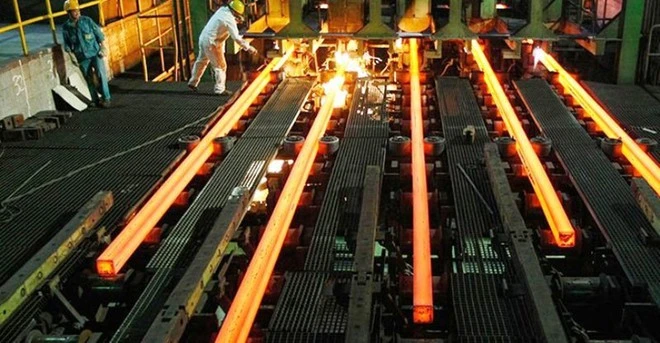
But now investors are being burdened with heavy risks such as surplus in supply, pressure from competition and huge loans, because steel share prices are continuing to fall drastically in the last two to three years.
Pressure from surplus supply
The biggest risk the steel companies are facing as of now is a surplus in supplies as several companies, especially the big ones, have been increasing their volume of production. For instance, Hoa Phat Group (HPG) has doubled its production volume for the period 2019-2020. It is estimated that the total amount of long steel products have been increased by 20-25% in 2019, mainly from HPG and Pomina Steel Corporation (POM). The amount of flat steel products from Hoa Sen Group (HSG) and Nam Kim Group (NKG) are estimated to have risen by 25-30% in 2019.
In order to carry out their production expansion plans, HSG and NKG are making big investments, and raising the debt-to-equity ratio in their two companies by three or four times. Therefore, in addition to the pressure of excessive supply, the companies are also under huge pressure for cash flow to maintain sales and for buying more required raw materials. Another difficulty has arisen from their main source of steel consumption in the real property sector. There are signs of slow sales of civil and commercial real estate property at the moment and expected to continue in coming years, making competition among the companies all the more intense.
However, these are not all the risks the domestic steel companies are facing. According to economic experts, a lot more difficulties for the steel sector are lying ahead, especially when the period of anti-dumping expires on 22 March 2020. After that, cheap steel products from China are expected to flood the Vietnamese market. Just behind the Republic of Korea, Vietnam is now the second biggest importer of Chinese steel products, making up 10% of its total exports.
Although the anti-dumping period is not over, domestic steel companies are under too much pressure from the Chinese market because the sales of steel products for the making of automobiles in China have not reached their targets for last fourteen consecutive months, and the excess amounts are flooding some Southeast Asian countries, including Vietnam. Apart from the domestic market, the Vietnamese steel products for exports are facing lots of trade charges, now accounting to 35 out of 142 investigations against Vietnamese products.
Negative business performance
Along with all the elements above, and with increased prices of raw materials over the past few months, listed steel companies are facing negative effects on their business performance, including all the major companies. According to the 2019 bi-annual financial statement, most of the steel companies have seen less positive business performance, with increased sales but decreased profits.
Take HPG for example, its sales increased by 11%, reaching VND 30,263 bn, but its net profit fell by 12.77%, at VND 3,860 bn. Most notably, SMC Trading Investment Joint Stock Company (SMC) saw its sales rise by 9% at VND 8,669 bn, but its gross profit dropped by 50% to VND 158 bn.
Although HSG, the most prominent steel company in the market, has cut down on its expenses, it still shows a year-on-year decrease in profits. According to the 3rd quarterly financial statement (2001-2019 fiscal period), HSG sales and net profit reached VND 21,685 bn (falling 16%) and VND 277 bn (plunging 46%), respectively. The company could achieve such a result because it managed to reduce VND3,300 bn of loans and whittle away about 100 branches throughout the country. Previously, HSG suffered a loss of over VND 100 bn in the fourth quarter of the fiscal year of 2017-2018.
The situation is much worse for small and medium-sized businesses (SMBs). Dana-Y Steel JSC (DNY) is among the businesses with the biggest losses on the securities market. According to the 2019 bi-annual financial statement, DNY reported a loss of over VND 171 bn, with an accumulated loss of almost VND 233 bn over the last three quarters. POM also saw a record loss of VND 132 bn. This figure is so disappointing in comparison with its plan to make a profit of VND 400 bn this year.
As explained by POM, it has made a loss because the company is conducting two projects of electroplating and blast furnace, increasing its year-on-year loan interest by 59%. Vietnam Italy Steel JSC (VIS) recorded a loss of nearly VND 66 bn, due to a decrease in selling price in the second quarter while it has had to raise commission for retailers because of competition in this sector.
Restructuring
The year 2019 is considered a watershed for restructuring plans to restore growth in the steel companies in coming years. For powerhouses like HPG, strategies to expand production and launch a new product (hot rolled steel sheets) will increase its added value for segments of straight steel (steel pipes and plated steel sheets).
Due to financial weaknesses, HSG will focus on improving its core business activities and reduce its speculation activities. Once the core business activities have established their advantage, the financial health will improve, heightening the market attitude towards HSG share prices, which have fallen rather low.
For SMBs, mergers and acquisitions (M&A) could be a great choice in their restructuring plans. SMC investment in NKG is a good example. In July, after the two companies announced their strengthened ties, SMC completed its acquisition of 6.3 million NKG shares, raising its ownership percentage to 5% and officially becoming biggest shareholder at NKG.
Previously in 2017, SMC bought NKG shares when NKG issued 30 million shares, which is about 30% of the company’s charter capital under resolution approved at the NKG General Shareholders Meeting. SMC said it wanted to strengthen its business relations and partnership with its strategic partner in the future. In fact, the business performance in the second quarter somehow indicated the changes at NKG after SMC got involved in the management.




















